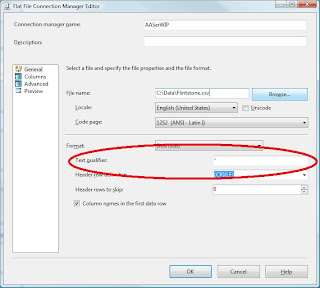Sunday, October 21, 2007
Max Column Length
DECLARE ColumnList CURSOR
FOR
SELECT c.[name] AS ColumnName
FROM sys.Columns c
JOIN sys.Tables t
ON c.Object_ID = t.Object_ID
WHERE t.Name = 'reyAASerWIP'
DECLARE @ColumnName varchar(30)
OPEN ColumnList
FETCH NEXT FROM ColumnList INTO @ColumnName
WHILE @@FETCH_STATUS = 0
BEGIN
PRINT @ColumnName
EXECUTE('SELECT MAX(LEN(RTRIM(' + @ColumnName+ '))) AS ' + @ColumnName + ' FROM reyAASerWIP ')
FETCH NEXT FROM ColumnList INTO @ColumnName
END
CLOSE ColumnList
DEALLOCATE ColumnList
Sunday, October 14, 2007
Importing CSVs with SSIS
The CSV import process is much more difficult with SSIS than it was for DTS. Scanning the MS newsgroups it looks like many of the problems will be corrected in SQL Server 2008. That's a long ways off, so let's look at some of the issues and how we can solve them.
Our CSV looks like this:
1- Name, Address, PhoneNumber, InvoiceAmount
2- "Fred Flintstone", "365 Stone Ave, BedRock, StoneAge", "928-555-1212", "25.00"
3- "Barney Rubble, "152 Granite Street, BedRock, StoneAge", "928.555.6326"
4- "Mister Slate", "52 Diamond Road", BedRock, StoneAge", "928.555.5332", "14.00"
The first problem is that there are commas enclosed by quotation marks in the Address field. SSIS will put BedRock as the PhoneNumber and StoneAge as the InvoiceAmount. This is very easy to solve. In the properties window of the Flat File Connection Manager, you will see a textbox labeled "Text qualifier." Just put a quotation mark in that field and it will see that the address column contains commas.
The next issue is that record #3 does not have the appropriate number of columns. It is one column short. DTS would handle this by inserting NULLs in the missing fields and then moving on to the next record. SSIS chokes on this. It will attempt to put "Mister Slate" in the InvoiceAmount field of record #3.
To solve this issue, I wrote the following script. I had to write it in VB.NET, since SSIS does not allow C# quite yet.
Imports System
Imports System.Data
Imports System.Math
Imports Microsoft.SqlServer.Dts.Runtime
Imports System.IO
Imports System.Text
Public Class ScriptMain
Public Sub Main()
Dim myLineCount As Int32 = 0
Dim myFilePath As String = Dts.Connections("FlintstoneCSV").ConnectionString
Dim myNewFilePath As String = Dts.Connections("NewFlintstoneCSV").ConnectionString
Dim myNewFile As FileInfo = New FileInfo(myNewFilePath)
Dim myNewFileStream As FileStream = myNewFile.Create()
Dim myFileStream As FileStream = New FileStream(myFilePath, FileMode.OpenOrCreate, FileAccess.ReadWrite, FileShare.ReadWrite)
Dim myStreamReader As New StreamReader(myFileStream)
Dim myStreamWriter As StreamWriter = New StreamWriter(myNewFileStream, Encoding.ASCII)
Dim myLine As String
Try
myLine = myStreamReader.ReadLine
While Not myStreamReader.EndOfStream
Dim myOffSet As Int32 = 1
Dim myBeginIndex As Int32
Dim myEndIndex As Int32
Dim myCount As Int32 = 0
Dim myColumnCount As Int32 = 41
Dim myCommaCount As Int32 = 0
Dim myChar As Char
'myLineCount += 1
'Dts.Events.FireInformation(0, "Cleaning CSV", "Processing Line " + myLineCount.ToString(), "", 0, True)
Dim myLineChars As Char() = myLine.ToCharArray()
While myCount <= myLineChars.Length - 1 If myLineChars(myCount) = """" Then myCount = InStr(myCount + 2, myLine, """") Else If myLineChars(myCount) = Convert.ToChar(",") Then myCommaCount += 1 End If myCount += 1 End If End While Dim myCommas As String = "" If myColumnCount - myCommaCount > 0 Then
myCommas = New String(Convert.ToChar(","), myColumnCount - myCommaCount)
End If
myStreamWriter.WriteLine(myLine.Replace(vbCrLf, "") + myCommas)
myLine = myStreamReader.ReadLine
End While
Dts.TaskResult = Dts.Results.Success
Catch ex As Exception
Dts.Events.FireError(0, "Cleaning CSV", "Encountered Error " + ex.Message _
+ " While Processing Line " + myLine, "", 0)
Dts.TaskResult = Dts.Results.Failure
Finally
myStreamReader.Close()
myStreamReader.Dispose()
myStreamWriter.Flush()
myStreamWriter.Close()
myFileStream.Close()
End Try
End Sub
End Class
Originally, I put a call to DTS.Events.FireInformational to tell us how many records have completed processing. It turns out that calls to DTS.Events are very, very slow. I removed those lines and processing was much, much faster.
I recently imported a CSV file with very dirty data. It included fields that will stretch across multiple rows and fields with quotes in the data. After struggling with SSIS, I finally decided to write my own CSV importer. As I was beginning my project and doing CSV research, I stumbled upon this project, called "A Fast CSV Reader."
http://www.codeproject.com/cs/database/CsvReader.asp
I used this code, along with a SQLBulkCopy object from DotNet 2.0. It imported 9 million large rows of dirty data in just a few minutes. I was amazed. What cleaning it didn't do, I will do in a SPROC.
Here is the extent of the code I wrote myself:
using (LumenWorks.Framework.IO.Csv.CsvReader
myCSVReader = new LumenWorks.Framework.IO.Csv.CsvReader(
new StreamReader("c:\\Data\\Flintstone.csv", Encoding.ASCII), true,
Convert.ToChar(",")
, Convert.ToChar("\""), Convert.ToChar("\\"), Convert.ToChar("#"), true))
{
myCSVReader.DefaultParseErrorAction = ParseErrorAction.ThrowException;
myCSVReader.MissingFieldAction = MissingFieldAction.ReplaceByEmpty;
myCSVReader.SkipEmptyLines = true;
myCSVReader.SupportsMultiline = true;
using (SqlBulkCopy myBulkCopy = new SqlBulkCopy(SqlHelper.ConnectionString))
{
myBulkCopy.DestinationTableName = "Destination";
myBulkCopy.BulkCopyTimeout = 30;
myBulkCopy.BatchSize = 10000;
myBulkCopy.WriteToServer(myCSVReader);
}
}
MessageBox.Show("Import Success");